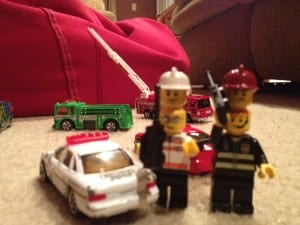A subscriber to the Situational Awareness Matters newsletter sent me a photograph of an emergency incident scene that caused me to reflect on a very important situational awareness lesson. This lesson, unfortunately, is often overlooked and is often implicated as a contributing factor to near-miss and casualty events. Let’s spend a little time examining workload management.
Here is the incident scene photograph that was sent to me by the father of six-year-old Caleb Ball. Caleb’s father, Will Ball, is the volunteer firefighter with of the Williamsport (MD) Fire Department and a career firefighter for the Hagerstown (MD) Fire Department.
Caleb was playing with his legos and set up an incident scene. Without prompting from dad, he put two heads on his incident commander and two heads on his safety officer. When his dad asked him why he did that, Caleb said a two-headed fire chief would do a better job.
Two heads are better than one
Indeed, Caleb! You’re probably a little young to understand the cliche that “Two heads are better than one.” But you’re certainly old enough to intuit the thinking power of two brains being greater than the thinking power of one brain. This underscores the lesson I want to share about brain capacity under stress.
Workload management
Whether it is physical workload or mental workload, each of us have limits and those limits are not created equally in every person. Issues of individual capacity aside, it is important to realize and acknowledge the limits to existing and, under stress, you’re going to reach those limits much sooner.
When a person reaches their physical workload limits the symptoms are very obvious and outwardly observable. They become physically exhausted and no longer able to carry their load. To cope with physical overload, a worker may shed some load to make their work easier. They may also stop to rest. Or they may ask someone to help them carry the load.
The outward signs of mental overload are not, unfortunately, as obvious. Neither the person being overloaded nor those around them may directly observe the symptoms. These symptoms may include confusion, forgetfulness, task fixation, tunnel vision, auditory exclusion, stress blindness, and more. If (and this is a big leap) a person would realize they are becoming mentally overloaded (which they are very likely not going to do until it is too late), they can employ some of the same tactics used for physical overload.
Shed some workload
In the cognitive arena, shedding workload means delegating. As tasks are delegated it frees up mental lifting capacity and makes it easier to carry the remaining load. However, this needs to happen EARLY. Think of it this way. You’re carrying a heavy physical load and collapsed from exhaustion. Even if you give some of your load to someone else to carry it’s going to take a considerable amount of time for you to recover and be able to resume your work. The same is true for mental overload. If you wait too long to delegate and your brain becomes fatigued it will take some time to recover.
Taking a rest
One of the best things you can do during high stress, high consequence work is to take periodic rests. This includes both physical rest and mental rest. All too often responders get consumed in their work and ignore the signs of fatigue and refuse to rest. I acknowledge it can be difficult to take rest periods during complex and time-compressed emergency scenes. The rests can be as simple as short pauses in the mental workload – the equivalent of ‘catching your breath.’
Share the heavy lifting
 Another tactic a commander can use is to share the cognitive heavy lifting. It is at this point where Caleb’s lesson becomes so important. Two brains really are better than one when it comes to managing complex, dynamic emergency scenes. I have spent a lot of time trying to understand the neuroscience behind decision making under stress. It is on that foundation of understanding that I can make this bold statement: The cognitive capacity needed to command a multiple company working incident (not to be confused with a multiple alarm incident) requires the mental capacity of more than one brain.
Another tactic a commander can use is to share the cognitive heavy lifting. It is at this point where Caleb’s lesson becomes so important. Two brains really are better than one when it comes to managing complex, dynamic emergency scenes. I have spent a lot of time trying to understand the neuroscience behind decision making under stress. It is on that foundation of understanding that I can make this bold statement: The cognitive capacity needed to command a multiple company working incident (not to be confused with a multiple alarm incident) requires the mental capacity of more than one brain.
A commander working alone at a multiple company working incident is the equivalent of a firefighter working alone inside a structure fire. It should never happen. And, if it does happen, everyone operating at the incident scene is vulnerable to the mental errors the commander may make (often unknowingly).
Command is a team event and the commander should be supported with a command aide or command advisor to be the second brain. The second person can then assume some of the mental workload, making it easier for the commander to develop and maintain situational awareness – especially Level 3 situational awareness – being able to predict future outcomes.
Thank you Caleb Ball for sharing your incident scene photos with me and for prompting this important lessons. At the command level, two heads are better than one!
About the Author
Richard B. Gasaway, PhD, CSP is widely considered a trusted authority on human factors, situational awareness and the high-risk decision making processes used in high-stress, high consequence work environments. He served 33 years on the front lines as a firefighter, EMT-Paramedic, company officer, training officer, fire chief and emergency incident commander. His doctoral research included the study of cognitive neuroscience to understand how human factors flaw situational awareness and impact high-risk decision making.
_____________________________________________________

If you are interested in taking your understanding of situational awareness and high-risk decision making to a higher level, check out the Situational Awareness Matters Online Academy.
CLICK HERE for details, enrollment options and pricing.
__________________________________
Share your comments on this article in the “Leave a Reply” box below. If you want to send me incident pictures, videos or have an idea you’d like me to research and write about, contact me. I really enjoy getting feedback and supportive messages from fellow first responders. It gives me the energy to work harder for you.
Let’s Get connected
Facebook: SAMatters
LinkedIn: Rich Gasaway
LinkedIn: Situational Awareness Matters
Twitter: Rich Gasaway
Youtube: SAMattersTV
itunes: SAMatters Radio
Stitcher Radio: SAMatters Radio
Google Play: SAMatters Radio
iHeart Radio: SAMatters Radio

